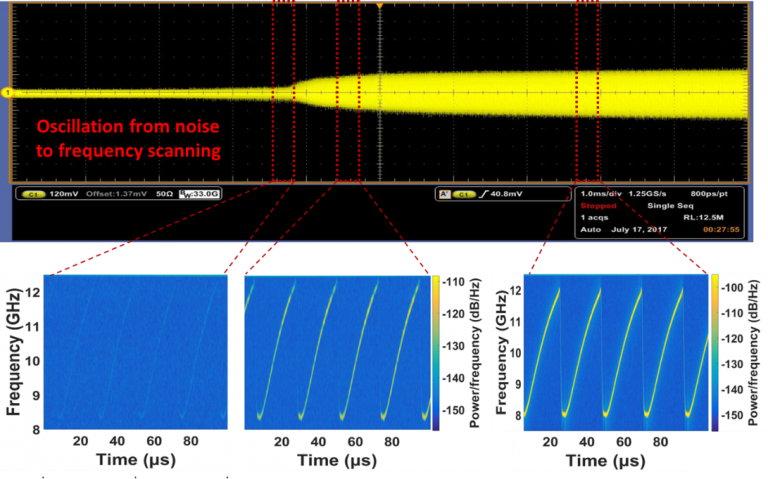Frequency scanning optoelectronic oscillator
Published in Physics
Radar and microwave communication systems have been invented many decades ago, but are still a growing area of research. For example, it is important for modern communication systems to be able to create microwave signals with fast-varying frequencies, called chirps. Optoelectronic oscillators are one way to produce ultra-low-noise microwave signals, but using them to produce a fast-varying signal with high quality is difficult, because a cavity-like component is used to reduce noise within these oscillators, and when the frequency is changed it takes time for a new low-noise frequency signal to build up in the cavity. In work published last month, we showed it is possible to have many frequencies oscillating in the system at once, so that the frequency can be changed rapidly without waiting for this build-up time. These simultaneous oscillations, all with locked phases, are made possible in a scheme known as Fourier-domain mode locking, which was previously applied to optical signals in lasers, but in this work is applied to microwaves using an optoelectronic oscillator .

An optoelectronic oscillator is like a laser, except that it has an optoelectronic cavity rather than a pure optical cavity. Although frequency-tunable optoelectronic oscillators have been widely studied, it is still a challenge to achieve continuous frequency scanning. Following the demonstration of frequency scanning lasers based on the Fourier domain mode locking technique in recent years, we wondered if it would be appropriate to extend this mode-locking principle to an optoelectronic oscillator.
In order to apply this technique to an optoelectronic oscillator, we needed a filter that could scan the selected frequency very rapidly — faster than what is made possible by most electrical schemes — so we decided to employ a microwave photonics solution that could perform faster tuning than electrical solutions.
One of the research interests of our group is semiconductor lasers. It is known that the lasing frequency of certain kinds of semiconductor lasers can be tuned by changing the driving current in a fast way. Fortunately, the passband of a microwave photonics filter based on phase-modulation to intensity-modulation conversion is related to the lasing frequency of the signal laser. Thus we achieved a fast frequency scanning microwave photonics filter by sweeping the frequency of the signal laser. Continuous frequency scanning microwave waveforms with very large time-bandwidth product are generated based on a Fourier domain mode locked optoelectronic oscillator. We run simulations that show that a Fourier domain mode locked optoelectronic oscillator oscillates in the same way as a conventional single-mode optoelectronic oscillator that uses the same optical and electronic components, except that the energy is shared by the many oscillation modes.
The employment of a Fourier domain mode locking technique in an optoelectronic oscillator provides an effective solution to generate frequency scanning microwave signals with large time-bandwidth product, which can find applications in radar and communication systems.
Ming Li
Reference: Hao T. et al, Breaking the limitation of mode building time in an optoelectronic oscillator. Nat. Commun. 9, 1839 (2018)
Follow the Topic
-
Nature Communications

An open access, multidisciplinary journal dedicated to publishing high-quality research in all areas of the biological, health, physical, chemical and Earth sciences.
Related Collections
With Collections, you can get published faster and increase your visibility.
Women's Health
Publishing Model: Hybrid
Deadline: Ongoing
Advances in neurodegenerative diseases
Publishing Model: Hybrid
Deadline: Dec 24, 2025



Please sign in or register for FREE
If you are a registered user on Research Communities by Springer Nature, please sign in